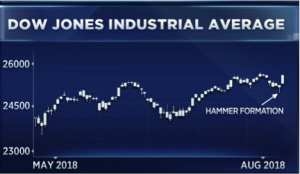

Yesterday, Gold opened down $2.50 at $1,188.50 in what seems to be a bit of breather after a strong two-day run. Today it is leveling at $1,195/ounce and seems to be making a steady recovery. If you missed the stock market ride up and are riding the crypto down, is it time to strike and invest in gold?
Gold hit its one year low recently, and though there seems to be more and more uncertainty with the ups and downs of crypto, the surprising strength of the dollar, and the stocks batting upwards despite several dips and dives, experts seem to agree that the future is bright and there are signs of good fortune for gold owners.
However, some say that it seems that the Dow is showing bullish signs heading into the fall. Ralph Acampora, also known as the ‘godfather of technical analysis’ pointed to Wednesday’s more than 300-point plunge and partial recovery as one bullish sign. He identified the Dow’s slight recovery as a “hammer pattern.”

“That configuration literally means that we could be making a reversal and suggesting maybe a near-term low… The Dow turned the corner…” Acampora said on CNBC’s “Futures Now” Thursday. And even the Dow’s lows this year has been supportive of his bullish claims.
"It made a low in April, and then another higher low in May and in June it made even a higher low, so [Wednesday's] candle I think I could call another higher low. In technical parlance, that's very, very encouraging," said Acampora.

Mapping and comparing secular bull markets is a risky business. No two are exactly the same, but at the same time, they do follow a general pattern moving from accumulation to public participation and finally excess mania with ebb and flow occurring at each stage. The Dow Jones Industrial Average began its 1980-2000 secular bull market at 760 and topped at 11,723 – rising roughly 15.5 times. Gold began its secular bull market in 2002 at $280 per ounce. If gold were to match the Dow’s performance, it would rise to $4300 per ounce by 2022 – a 15.5 times gain. That said, the timeline for bull markets can vary – some shorter, others longer. In gold’s secular bull market of the 1970s, it rose 24 times in a ten-year period – from $35 per ounce to $850 per ounce. If it were to match that price performance, it would be priced at $6500 per ounce
But, all bull runs must come to an end. Nothing lasts forever, and many also foresee the bull run ending its historic run, including Daniel Ghali, commodities strategist at TD Securities, who told Reuters: “We’re seeing a bid in the dollar that's driving the gold low today, but we do think the dollar is set to weaken going forward, so we do see gold trading higher on the near term, two to three months outlook.”
Evidence suggests that we are about to see the final rise of the longest bull market in history. On Tuesday, the S&P 500 will equal the longest U.S. bull market since World War II; on August 22, it will be the longest in history at nearly 3,500 days. But many view this recent upper breakout to be an indicator of this market in its final stages of completing a larger top formation. Again, all bull runs come to an end, and perhaps it will be sooner rather than later.
Investors who learn to view these situations as opportunities instead of catastrophes can make a lot of money in these cyclical markets. At present, Gold has a very enticing buy low, high return potential considering it performs the way experts hope and envision. Last year, gold bottomed right around this time and took off on a rally culminating in the first week of September with a gain of 11.2%.
It’s hard to remain patient these days, but the fact remains that gold is a bargain at present, and history shows us that these low points often point toward a burgeoning rally. The last time the large speculators went net short in gold was January 2016 — just a couple of weeks after gold had reached its major, long-term bottom. The rally that followed this previous event was extraordinary — gold soared over 19% and many of the junior and senior mining stocks multiplied in price.
There is also the massive $21.4 trillion elephant in the room that continues to put pressure on the American market and especially the dollar. The US Federal debt is so large that it demands an incredibly significant depreciation of the US dollar, and it soon may get what it asks for… Every developed country is also experiencing its own form of a continuously mounting national debt and with that the potentiality for every major currency to also devalue in a big way. The long-term inevitability is that gold will ultimately come out on top once the dollar weakens and gives in to the demands of the national debt and other developed countries’ national debts.
Posting in: